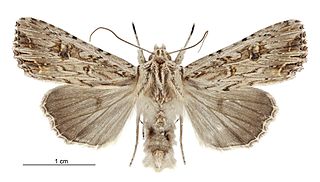
Ichneutica lignana is a moth of the family Noctuidae. It is endemic to New Zealand. This species is found on the Three Kings Islands as well as the North, South and Stewart Islands. This species lives in a variety of habitats including coastal areas, tussock grasslands, shrublands, and native forest, at a range of altitudes from sea level to over 1300 m. I. lignana is quite distinctive in appearance with its dark markings on the abdomen and forewings although it is possible to confuse Ichneutica morosa, Meterana pansicolor and Meterana pascoi with this species. Adults are on the wing throughout the year in the northern parts of the New Zealand but are restricted to the months of October to April in the more southern parts of the country.

Ichneutica semivittata is a moth of the family Noctuidae. It is endemic to New Zealand. It can be found from the Three King Islands down to Stewart Island. The similar species I. sulcana can be distinguished from I. semivittata as the former is much larger, has a darker hindwing and abdomen and has only one to three spots located behind the middle of the forewing in comparison to the 8 or 9 of I. semivittata. This species lives in a variety of habitats from open grasslands to clearings in forest and at a range of altitudes from the sea level to the alpine zone. Larval host species include Juncus procera, Carex secta as well as on tussock grasses such as Poa cita, P. colensoi and Festuca novae-zelandiae. Adults of this species are on the wing from August to April and are attracted to light.

Ichneutica maya is a moth of the family Noctuidae. It is endemic to New Zealand. It is found in the mountains in southern half of the North Island and in the South Island. I. maya is a distinctively coloured and patterned moth and as such is unlikely to be confused with similar species. I. maya can be found in the southern half of the North Island down through the South Island. This species can be found in alpine to subalpine zones with high rainfall but in Southland this species can be found down to sea level. This life history in the wild is unknown, nor has its larval host species been confirmed. Adults are on the wing from December to March and are attracted to sugar and light traps.

Ichneutica morosa is a moth of the family Noctuidae. It is endemic to New Zealand and is found in the southern parts of the North Island and throughout the South Island. I. morosa is common in the eastern parts of both those islands and also in Fiordland. I. morosa can be found from altitudes ranging from lowlands to the alpine zone. I. morosa is absent from the range of its closely related species I. mustulenta, that is from the northern North Island. The larvae of I. morosa are known to feed on Poa astonii and also on other Poa species including introduced species. As well as its standard form the adult moths have a grey colour morph with the head and thorax being a grey and mottled brown, and the forewing being a pale greyish ochreous to a deep brown, suffused with grey. I. morosa can be confused with I. mustulenta and I. lignana. Adults are on the wing from November to April.

Ichneutica scutata is a moth of the family Noctuidae. It is endemic to New Zealand. This species can be found in the southern parts of the North Island as well as the eastern parts of the South Island. It is similar in appearance to I. insignis and I. skelloni but can be distinguished as I. scutata is much paler in appearance. It is likely this species inhabits lowland tussock grasslands as well as coastal dunes although it is not common in inland tussock grasslands. The larvae feed on a variety of herbaceous plants such as Plantago and Convolvulus species, Plagianthus divaricatus. It pupates on soil near its host plants. The adults are on the wing from late March to July.
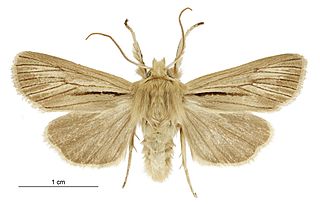
Ichneutica acontistis is a moth of the family Noctuidae. It is endemic to New Zealand and is found only in the South Island, mainly on the eastern side although not in the Nelson district. This species is similar in appearance to I. paraxysta,I. stulta and I. toroneura. I. acontistis is unlikely to be confused with I. paraxysta as the later is only found in the North Island. I. acontistis can be distinguished from I. stulta as the latter species has a strongly curved forewing edge where as I. acontistis' is straight. I. acontistis can be distinguished from I. toroneura as the former has a dark stroke of colour starting from the base of the forewing that I. toroneura lacks. I. acontistis inhabits tussock grasslands and the larvae of this species feed on species of grass found in the genera Poa, Elymus and Rytidosperma. It pupates under rocks and adults are on the wing from September to January. I. acontistis are attracted to light.

Ichneutica atristriga is a moth of the family Noctuidae. It is endemic to New Zealand and is found through out the North, South and Stewart Islands. The larval hosts likely include tussock grasses included Poa cita, P. colensoi and Festuca novae-zelandiae. Larvae have been reared on species in the genera Bromus and Festuca. The adults of this species are on the wing from November to May. I. atristriga can possibly be confused with the smaller species I. propria. However I. atristriga has thorax and forewings that have a pinkish tinge and I. propria has a dark streak on the discal part of the forewing which I. atristriga lacks. A study has indicated that the population numbers of this species have decreased.
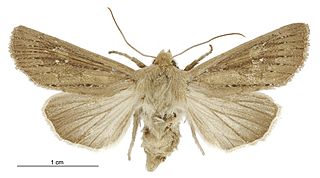
Ichneutica phaula is a moth of the family Noctuidae. It is endemic to New Zealand. It is found only in the South Island in the Nelson district, the eastern side of the South Island and Stewart Island. I. phaula inhabits tussock grasslands and coastal sand dunes. Host species include Ficinia spiralis, Ammophila arenaria, Poa cita and other "tussock grasses". The adults of this species are on the wing from October to December and are attracted to sugar traps. I. phaula is similar in appearance to both I. micastra, with whom it does not share a range, and I. sapiens which differs from I. phaula as I. sapiens is darker and has a more reddish tinge.

Ichneutica unica is a species of moth in the family Noctuidae. It is endemic to New Zealand and is found in the centre of the North Island and throughout the South Island. This moth is very similar in appearance to its close relatives Ichneutica phaula and Ichneutica toroneura. I. phaula can be distinguished as there is a difference in pectinations on the male antennae and I. toroneura can be distinguished as the black vein markings on the forewings is more uniform for that species in comparison to I. unica. I. unica is variable in appearance with the North Island specimens having a darker brown colour on the forewings and having a darker underside of the hindwings. This species inhabits open tussock grassland at various altitudes, coastal dunes, and inland volcanic dunes. Larvae feed on tussock grasses such as Chionochloa pallens and species in the genus Poa. Adult moths are on the wing from November to February and are attracted to both sugar and light traps.

Ichneutica averilla is a moth of the family Noctuidae. It is endemic to New Zealand. This species is found in the North Island at Mount Taranaki but is widespread throughout the South Island and Stewart Island. It prefers mountainous habitat but can be found down to sea level in the southern parts of the South Island. Adults of the species are on the wing between November and March. Larvae likely exist on a variety of herbaceous plants but have been recorded as feeding on species within the genus Plantago. This species is sometimes confused with I. mutas but can be distinguished from the latter on the basis of forewing colour as well as the absence of or an indistinct antemedian forewing line.

Ichneutica toroneura is a moth of the family Noctuidae. It is endemic to New Zealand. This species is similar to I. unica but can be distinguished from that species by the uniform black vein markings on the forewings of I. toroneura. It is also similar in appearance to I. acontistis but the base of the forewings of I. toroneura lack the dark stripe that can be found on the forewings of I. acontistis. The males of I. toroneura have longer pectinations on their antennae. I. toroneura is found in the centre of southern South Island in the tussock grasslands of Central Otago and the Mackenzie Basin. Larvae feed on tussock grasses Poa cita and Festuca novae-zelandiae. Adults are on the wing from November to January.

Ichneutica paraxysta is a moth of the family Noctuidae. It is endemic to New Zealand. This species is very similar in appearance to its close relative I. acontistis but as the range of the two species do not overlap this is unlikely to cause confusion. I. paraxysta is only found in the North Island at the subalpine zones in the Mount Taranaki region and at Mount Ruapehu. It prefers tussock grassland and shrubland habitat. The life history of this species is unknown as are the host species of its larvae however it has been hypothesised that the larval host plants are species in the genera of Poa and Festuca.

Ichneutica epiastra is a moth of the family Noctuidae. It is endemic to New Zealand and is found throughout the North, South and Stewart Islands. This species prefers open habitats such as wetlands, dunes and forest clearings. Eggs are laid in the summer or autumn and larvae feed during winter and spring. The larval host species are found within the genus Austroderia. The adult moths are on the wing between October and February. Adult I. epiastra can possibly be confused with the similar species I. arotis and I. haedifrontella however there are differences in appearance that enables I. epiastra to be distinguished from these two species. In particular I. epiastra has long sharp-tipped ‘horns' on its head that are diagnostic. The adults of this species appear reluctant to be attracted to light although they do come more frequently to the brighter mercury vapour traps.
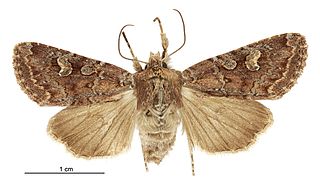
Ichneutica agorastis is a moth of the family Noctuidae. This species is endemic to New Zealand. This moth is similar in appearance to two other species in the genus but can be distinguished through the colour and size of its forewings. This species is found in the South Island and Stewart Island in open habitats in the subalpine zone. However, in Southland I. agorastis can be found down to sea-level. Adult moths are on the wing between January and April. The life history and host species are unknown.

Ichneutica cuneata is a moth in the family Noctuidae. It is endemic to New Zealand. I. cuneata is found in and around the Tongariro National Park in the North Island and throughout the South Island. Specimens found in Tongariro National Park tend to be darker in appearance than South Island specimens but as their colour is variable, and antennae and genitalia of both species are consistent, they are not now regarded as a separate species. I. cuneata inhabits tussock grasslands and shrublands in alpine and subalpine zones. The adults are on the wing from December to April and can be found flying during the day. The life history of I. cuneata is unknown as are the specific host species of its larvae. However larvae of I. cuneata are said to feed on herbaceous plants. The adults of this species also pollinate native species such as Myosotis macrantha.

Ichneutica ceraunias is a moth of the family Noctuidae. It is endemic to New Zealand. This species is found from the central North Island to the bottom of the South Island. Hosts of the larvae are species of Chionochloa and Festuca. This colourful moth is variable in appearance and can be mistaken for Ichneutica dione. Adults are on the wing from October to February.

Ichneutica disjungens is a moth of the family Noctuidae. This species is endemic to New Zealand and can be found on the central volcanic plateau of the North Island and in the eastern as well as the south western parts of the South Island. I. disjungens inhabits tussock grasslands in the alpine and subalpine zones. The hosts of the larvae of this species include Poa cita, P. colensoi, and Festuca novae-zelandiae. The adults of this species are distinctive and are unlikely to be confused with other species. They are on the wing between October and March.

Ichneutica erebia is a moth of the family Noctuidae. This species is endemic to New Zealand and is found on Campbell Island and the Auckland Islands. Adults of this species are on the wing from August to January. The adults are variable in appearance but can be distinguished from similar species by the patters or lack thereof on their forewings. The larvae of I. erebia are polyphagous and hosts include Pleurophyllum criniferum, species within the genera Stilbocarpa and Carex, as well as Chionochloa antarctica, Urtica australis and Raukaua simplex.

Ichneutica paracausta is a moth of the family Noctuidae. This species is endemic to New Zealand. It is found locally in the central North Island, is widespread in the South Island and can also be found in Stewart Island. I. paracausta is variable in colour, but as it has a distinctive black streak on its forewing as well as a wing pattern that is characteristic, I. paracausta is unlikely to be confused with other species. It is present on the North Island volcanic plateau as well as Little Bush Reserve in Hawkes Bay in the North Island as well as in tussock grassland, alpine and subalpine shrubland and in alpine forest. Larvae have been recorded as feeding on grasses, a pupa has been found in a cocoon under the bark of a tree and adult moths are on the wing from October to January.
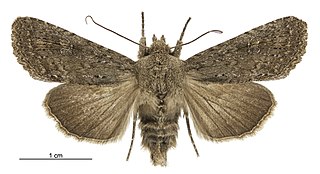
Physetica homoscia is a species of moth of the family Noctuidae. It is endemic to New Zealand and is found throughout New Zealand including in the Auckland Islands. This species inhabits places where its host plants are common and this includes costal dune habitat. It lives at a wide range of altitudes from sea-level up to at least 1750 m. The larvae of P. homoscia feed on Ozothamnus leptophyllus and Ozothamnus vauvilliersii. They are very active and drop to the ground when disturbed. Larvae are parasitised by a species of fly. This species pupates in the soil and the pupa life stage lasts for approximately 6 weeks. The adult moths are on the wing from September to June and are attracted to light. The adults of P. homoscia might possibly be confused with Ichneutica moderata however this latter species lacks the small white dots on the forewing veins of P. homoscia. Adults might also be confused with P. temperata but P. homoscia is significantly larger in size.























